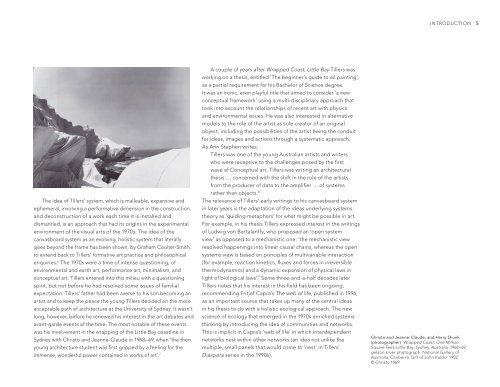introduction: a work in progress - National Gallery of Australia
introduction: a work in progress - National Gallery of Australia
introduction: a work in progress - National Gallery of Australia
Create successful ePaper yourself
Turn your PDF publications into a flip-book with our unique Google optimized e-Paper software.
INTRODUCTION 5<br />
The idea <strong>of</strong> Tillers’ system, which is malleable, expansive and<br />
ephemeral, <strong>in</strong>volv<strong>in</strong>g a performative dimension <strong>in</strong> the construction<br />
and deconstruction <strong>of</strong> a <strong>work</strong> each time it is <strong>in</strong>stalled and<br />
dismantled, is an approach that had its orig<strong>in</strong>s <strong>in</strong> the experimental<br />
environment <strong>of</strong> the visual arts <strong>of</strong> the 1970s. The idea <strong>of</strong> the<br />
canvasboard system as an evolv<strong>in</strong>g, holistic system that literally<br />
goes beyond the frame has been shown, by Graham Coulter-Smith,<br />
to extend back to Tillers’ formative art practice and philosophical<br />
enquiries. 6 The 1970s were a time <strong>of</strong> <strong>in</strong>tense question<strong>in</strong>g, <strong>of</strong><br />
environmental and earth art, performance art, m<strong>in</strong>imalism, and<br />
conceptual art. Tillers entered <strong>in</strong>to this milieu with a question<strong>in</strong>g<br />
spirit, but not before he had resolved some issues <strong>of</strong> familial<br />
expectation. Tillers’ father had been averse to his son becom<strong>in</strong>g an<br />
artist and to keep the peace the young Tillers decided on the more<br />
acceptable path <strong>of</strong> architecture at the University <strong>of</strong> Sydney. It wasn’t<br />
long, however, before he renewed his <strong>in</strong>terest <strong>in</strong> the art debates and<br />
avant-garde events <strong>of</strong> the time. The most notable <strong>of</strong> these events<br />
was his <strong>in</strong>volvement <strong>in</strong> the wrapp<strong>in</strong>g <strong>of</strong> the Little Bay coastl<strong>in</strong>e <strong>in</strong><br />
Sydney with Christo and Jeanne-Claude <strong>in</strong> 1968–69, when ‘the then<br />
young architecture student was first gripped by a feel<strong>in</strong>g for the<br />
immense, wonderful power conta<strong>in</strong>ed <strong>in</strong> <strong>work</strong>s <strong>of</strong> art’. 7<br />
A couple <strong>of</strong> years after Wrapped Coast, Little Bay Tillers was<br />
<strong>work</strong><strong>in</strong>g on a thesis, entitled ‘The beg<strong>in</strong>ner’s guide to oil pa<strong>in</strong>t<strong>in</strong>g’,<br />
as a partial requirement for his Bachelor <strong>of</strong> Science degree.<br />
It was an ironic, even playful title that aimed to consider ‘a new<br />
conceptual frame<strong>work</strong>’ us<strong>in</strong>g a multi-discipl<strong>in</strong>ary approach that<br />
took <strong>in</strong>to account the relationships <strong>of</strong> recent art with physics<br />
and environmental issues. He was also <strong>in</strong>terested <strong>in</strong> alternative<br />
models to the role <strong>of</strong> the artist as sole creator <strong>of</strong> an orig<strong>in</strong>al<br />
object, <strong>in</strong>clud<strong>in</strong>g the possibilities <strong>of</strong> the artist be<strong>in</strong>g the conduit<br />
for ideas, images and actions through a systematic approach.<br />
As Ann Stephen writes:<br />
Tillers was one <strong>of</strong> the young <strong>Australia</strong>n artists and writers<br />
who were receptive to the challenges posed by the first<br />
wave <strong>of</strong> Conceptual art. Tillers was writ<strong>in</strong>g an architectural<br />
thesis … concerned with the shift <strong>in</strong> the role <strong>of</strong> the artists<br />
from the producer <strong>of</strong> data to the amplifier … <strong>of</strong> systems<br />
rather than objects. 8<br />
The relevance <strong>of</strong> Tillers’ early writ<strong>in</strong>gs to his canvasboard system<br />
<strong>in</strong> later years is the adaptation <strong>of</strong> the ideas underly<strong>in</strong>g systems<br />
theory as ‘guid<strong>in</strong>g metaphors’ for what might be possible <strong>in</strong> art.<br />
For example, <strong>in</strong> his thesis Tillers expressed <strong>in</strong>terest <strong>in</strong> the writ<strong>in</strong>gs<br />
<strong>of</strong> Ludwig von Bertalanffy, who proposed an ‘open system<br />
view’ as opposed to a mechanistic one: ‘the mechanistic view<br />
resolved happen<strong>in</strong>gs <strong>in</strong>to l<strong>in</strong>ear causal cha<strong>in</strong>s, whereas the open<br />
systems view is based on pr<strong>in</strong>ciples <strong>of</strong> multivariable <strong>in</strong>teraction<br />
(for example, reaction k<strong>in</strong>etics, fluxes and forces <strong>in</strong> irreversible<br />
thermodynamics) and a dynamic expansion <strong>of</strong> physical laws <strong>in</strong><br />
light <strong>of</strong> biological laws’. 9 Some three-and-a-half decades later<br />
Tillers notes that his <strong>in</strong>terest <strong>in</strong> this field has been ongo<strong>in</strong>g,<br />
recommend<strong>in</strong>g Fritj<strong>of</strong> Capra’s The web <strong>of</strong> life, published <strong>in</strong> 1996,<br />
as an important source that takes up many <strong>of</strong> the central ideas<br />
<strong>in</strong> his thesis to do with a holistic ecological approach. The new<br />
science <strong>of</strong> ecology that emerged <strong>in</strong> the 1970s enriched systems<br />
th<strong>in</strong>k<strong>in</strong>g by <strong>in</strong>troduc<strong>in</strong>g the idea <strong>of</strong> communities and net<strong>work</strong>s.<br />
This is implicit <strong>in</strong> Capra’s ‘web <strong>of</strong> life’ <strong>in</strong> which <strong>in</strong>terdependent<br />
net<strong>work</strong>s nest with<strong>in</strong> other net<strong>work</strong>s (an idea not unlike the<br />
multiple, small panels that would come to ‘nest’ <strong>in</strong> Tillers’<br />
Diaspora series <strong>in</strong> the 1990s).<br />
Christo and Jeanne-Claude, and Harry Shunk<br />
(photographer) Wrapped Coast, One Million<br />
Square Feet, Little Bay, Sydney, <strong>Australia</strong> 1968–69<br />
gelat<strong>in</strong> silver photograph <strong>National</strong> <strong>Gallery</strong> <strong>of</strong><br />
<strong>Australia</strong>, Canberra Gift <strong>of</strong> John Kaldor 1982<br />
© Christo 1969

















